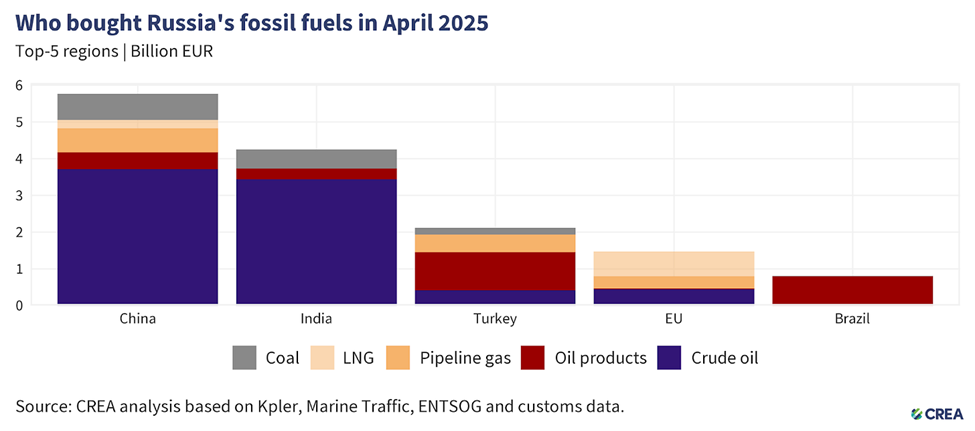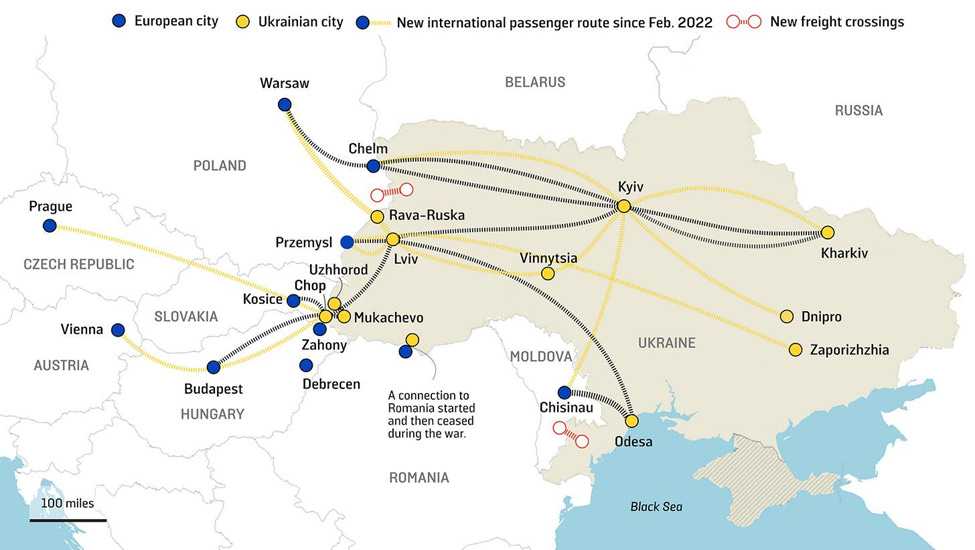(…continued from Part 2…)
***
Diplomacy
Two weeks ago, a Sukhoi Su-27 fighter jet of the Russian Air-Space force violated Estonian airspace while Estonia tried to detain a shadow fleet ship. How good NATO is ‘air policing’ - even ‘protecting’ - the airspace over the three Baltic countries…
Then Russia detained a ship leaving an Estonian port as it entered Russian waters on a route agreed upon by Russia and Estonia. Now the Russians are escorting shadow ships in the Baltic Sea with aircraft. Two Russian aircraft violated Finnish airspace south of Porvoo during an escort. It is the second violation of Finnish airspace since February.
In addition to the US Senate bill that would slap 500% tariffs on anyone that buys Russian energy products, an identical bill was introduced in the House. There’s also a Senate bill with bipartisan support that Russia must return the 19,546 Ukrainian children before peace is finalized. While there is overwhelming support in the Republican-led senate, there are no guarantees the tariff bill would be passed in the Republican-led house, or even brought up for a vote. For that matter, there’s no guarantee it will be brought up for a vote in the senate for a vote without Trump’s approval, to the irritation of some Republican senators. Trump wants to do business with Putin and already indicated he will not join Europe in additional sanctions on Russia.

The EU sanctioned 25 individuals and 6 entities for developing and using chemical weapons. The UK also sanctioned the supply chain of Russian weapon systems.
Three Ukrainians that planned to send explosives on freight transports in Germany on behalf of Russia were arrested in Germany and Switzerland.

A Romanian defense journalist talked about many issues during an interview: The recent elections in which Georgescu claimed he had zero campaign expenses, and the Russian and Chinese interference. Despite the influence, 12 Russian invasions of Romania and a communist regime means Russia will never be beloved. Romania’s GDP tripled since joining the EU, and, since 2007, Romania contributed €30 billion to the EU and received €100 billion. After years of no investments it is increasing defense spending to 3.5%, even without a strong economy, and it bought Korean artillery and tanks and some US tanks, and is rebuilding its reserve forces. They plan to produce 155mm shells. Problem: the Romanians have to import gunpowder from Serbia and China…. becasue the three domestic gunpower factories, left over from the Communist era, first have to be restored.
***
Equipment
Ten IRIS-T air defense systems were delivered to Ukraine at the beginning of the month.
A Ukrainian drone company codified five models of fiber optic drones with ranges from 10-20 km and various configurations of batteries and payloads.
Drones that fly long distances require wings and Ukraine is developing drones that are effective at 30-40 km.
The multi-national KNDS defense company is working with Ukraine to produce medium caliber ammo. This is yet another effort to arm Ukraine by producing ammo and equipment inside Ukraine.
Rheinmetall is working with India to produce 200,000 shells, 10,000 tons of explosives and 2,000 tons of rocket propellant in Maharashtra. This deal will also increase Rheinmetall’s access to raw materials and expand the resilience of its supply chain.
The UK unveiled the SG-1, an AI drone sub weighing 60 kgs that can cruise for up to three months. The sub network will track Russian ships and submarines and the shadow fleet using their acoustic signatures. Once a target is detected, the drone surfaces to provide positioning information and drone sub swarm coordination through satellite communications.
Germany and the UK will jointly develop a precision strike weapon with a range of 2,000 km.
Australia is sending 49 M-1 tanks to Ukraine despite (private) US objections, which questions how useful they’d be on the battlefield. What a surprise there are concerns about Ukrainian difficulties to maintain them. At least Australia does have US official permission to deliver them.
Russia has a cargo drone that can carry 300kg up to 500km far.
Poland wants to buy 1,400 GBU-39 bombs and 788 PAC-2 Patriot missiles. The US is considering the request and an expected delivery date wasn’t provided. The PAC-2 missile can intercept ballistic missiles and Ukraine has very few missiles that can intercept ballistic missiles.
A shipment of five tons was declared to be truck and bus tires but were actually sanctioned airplane tires. It was sent from a company in Spain to a receiver in Azerbaijan and the Poles intercepted it on the border with Belarus. Russia has difficulty maintaining their aircraft due to sanctions.
A conventional radar sends out the electromagnetic waves and detects any reflection from a target, potentially revealing its distance, size and speed. Quantum radar sends half of an entangled pair of photons towards the target while the other half remains at the radar site. When a photon is returned, it can easily be distinguished from background clutter, exponentially increasing signal-to-noise resolution over unentangled illumination. Stealth aircraft provide a weak return signal which could aid quantum radars in detecting it with the differentiation between the weak signal and strong background returns. It might also be able to differentiate between genuine and decoy warheads based on their different signal characteristics. Canadian and Austrian prototypes have proven the concept in a laboratory environment of a couple meters. China claimed that they detected an object 100 km away that many view with skepticism. The US says that the physics of a quantum radar are sound but it may have low potential for long-range use with current technology.

***
Rail Networks
A year ago, Finland was considering converting their rail network to the European network to better integrate with Norway and Sweden, and to improve their own security. Back when the US supported NATO, US military equipment was transported on both rail and road from Narvik, Norway, through Sweden and into Finland for the “Northern Forest” exercise. They are now preparing to re-build their railroads to European regulations in 2032, which covers not just the width of the rails, but the ability to support 160+ km/h speeds, 740 meter long trains, access to all airports that serve 12 million passengers a year, signal systems and other factors.

There is a 123 km long European gauge track that connects between the Lithuanian city of Kaunas and the Polish border and a 2030 project to extend that line by 870km to the Estonian port capital of Tallinn.
Out of 24,400 km of Ukrainian rail, only 155 km have the European gauge. There are plans to increase connectivity with Europe, but that’s going to take some time.
If you think Ukraine is ‘late’ into this business, please mind: Spain alone has seven different track gauges and uses a track gauge changer to change the width of the wheels on a train while moving. Ukraine signed an agreement to use Spanish technology, which means its engines and cars would need to be built with variable width axles. It can also create dual gauge or parallel tracks, allowing trains to run on the same track or alongside it.
In 2023, the EU proposed to build a European gauge track alongside existing tracks to connect to the Moldovan capital of Chisinau. This track would carry higher speed passenger service and international freight. The first step is to electrify the 15 km stretch of rail between Iasi, Romania and Ungheni, Moldova. That is expected to take 36 months. Some time later, the route will be extended to Chisinau.
For their part, rail service between Georgia and Russia ended with the Russian invasion of Abkhazia. A pro-Russian government in Georgia attended meetings in Moscow to discuss reopening of rail traffic. Even though the route transits Abkhazia, they were not involved in the talks.
BTW, there are similar - ‘infrastructure-related’ - works going on in Slovenia and Croatia, too. For example, the Cerklje Air Base in south-eastern Slovenia should have received a fuel pipe-line, and RUMINT has it, it is in the process of being expanded to a capability to support a ‘squadron worth’ of tanker aircraft. Yet another (rumoured) example: Rafale fighter-jets recently delivered to Croatia should be ‘a-wired’. Read: capable of deploying nuclear weapons. Reportedly, their crews underwent corresponding training, too.







Cherry picking
On December 15, 2024, two Russian oil tankers, Volgoneft-212 and Volgoneft-239, sank in the Black Sea's Kerch Strait after being caught in a storm. The accident resulted in an oil spill, estimated to be between 2,500 and 4,500 tons.
So they are a risk
According to the Estonian Defence Force, the 20-year-old oil tanker Jaguar, (IMO: 9293002) as it was quickly renamed, was “a vessel without a nationality” at the point the Estonian navy sought to verify the vessel’s documents and legal status on the evening of May 13.
Estonia was right to try to stop the vessel;
Unflagged vessels pose several risks including potential for illicit activity, safety and environmental hazards, and challenges in enforcing regulations, and are not insured.
As someone who lived in Narvik for some years any news of the railroad there is quite interesting. You wrote: «Back when the US supported NATO, US military equipment was transported on both rail and road from Narvik, Norway, through Sweden and into Finland for the “Northern Forest” exercise. They are now preparing to re-build their railroads to European regulations in 2032,» Yes, that rairoad is important and very much in use. Iron from Kiruna in Sweden has been transported and sent from Narvik for more than a century. And going on at ever higher level. But that railroad is single track, and while relatively short it is difficult (to put it mildly) to get double track. But yes, this project has a lot of civilian benefits simply due to the importance of the railroad for civilian purposes. So it will happen (probably cost more than expected but what else is new) and the harbour infrastructure is upgraded in the Narvik area. And it could be a vital link to Finland as described.